brake rotor INFINITI QX60 2023 Owners Manual
[x] Cancel search | Manufacturer: INFINITI, Model Year: 2023, Model line: QX60, Model: INFINITI QX60 2023Pages: 636, PDF Size: 7.28 MB
Page 473 of 636
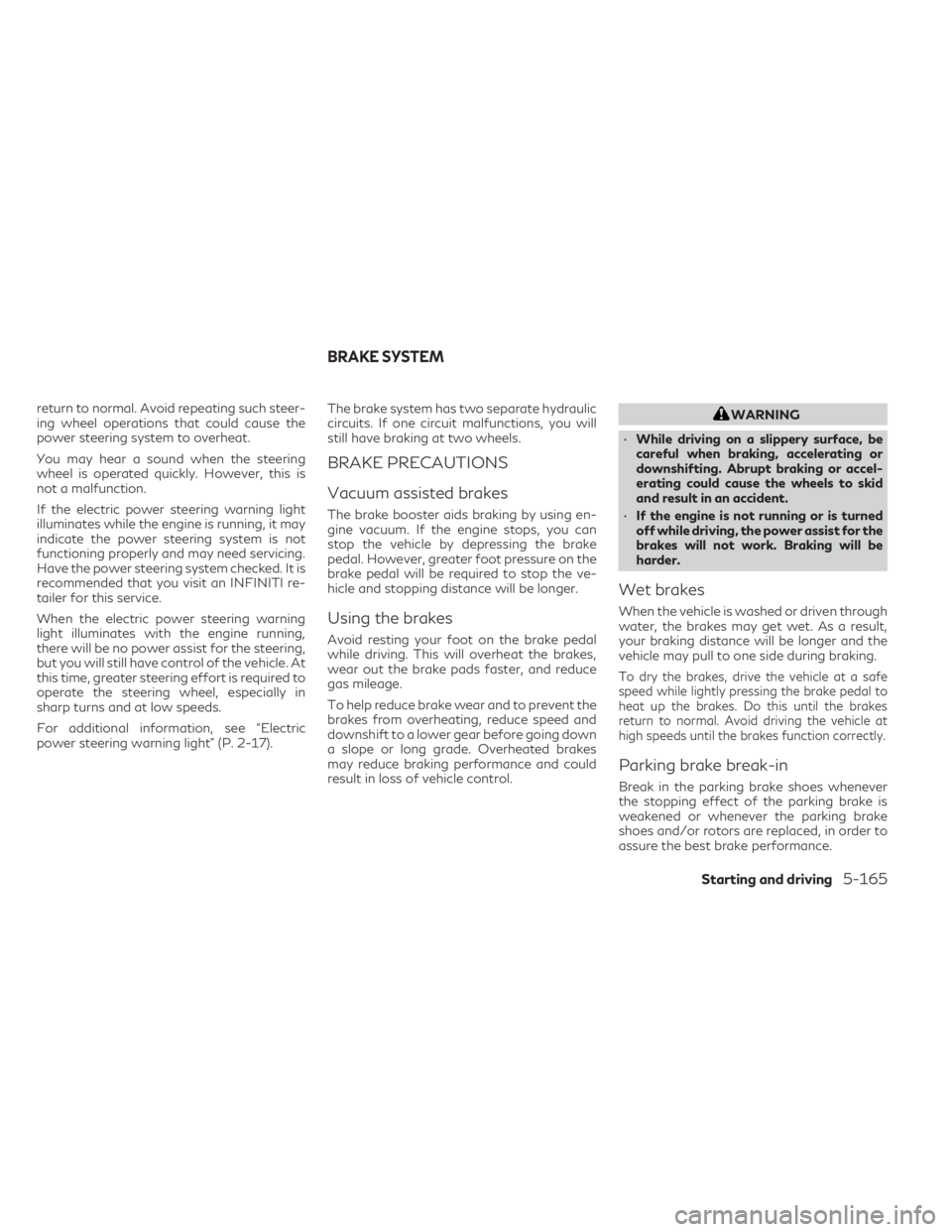
return to normal. Avoid repeating such steer-
ing wheel operations that could cause the
power steering system to overheat.
You may hear a sound when the steering
wheel is operated quickly. However, this is
not a malfunction.
If the electric power steering warning light
illuminates while the engine is running, it may
indicate the power steering system is not
functioning properly and may need servicing.
Have the power steering system checked. It is
recommended that you visit an INFINITI re-
tailer for this service.
When the electric power steering warning
light illuminates with the engine running,
there will be no power assist for the steering,
but you will still have control of the vehicle. At
this time, greater steering effort is required to
operate the steering wheel, especially in
sharp turns and at low speeds.
For additional information, see “Electric
power steering warning light” (P. 2-17).The brake system has two separate hydraulic
circuits. If one circuit malfunctions, you will
still have braking at two wheels.
BRAKE PRECAUTIONS
Vacuum assisted brakes
The brake booster aids braking by using en-
gine vacuum. If the engine stops, you can
stop the vehicle by depressing the brake
pedal. However, greater foot pressure on the
brake pedal will be required to stop the ve-
hicle and stopping distance will be longer.
Using the brakes
Avoid resting your foot on the brake pedal
while driving. This will overheat the brakes,
wear out the brake pads faster, and reduce
gas mileage.
To help reduce brake wear and to prevent the
brakes from overheating, reduce speed and
downshift to a lower gear before going down
a slope or long grade. Overheated brakes
may reduce braking performance and could
result in loss of vehicle control.
WARNING
• While driving on a slippery surface, be
careful when braking, accelerating or
downshifting. Abrupt braking or accel-
erating could cause the wheels to skid
and result in an accident.
• If the engine is not running or is turned
off while driving, the power assist for the
brakes will not work. Braking will be
harder.
Wet brakes
When the vehicle is washed or driven through
water, the brakes may get wet. As a result,
your braking distance will be longer and the
vehicle may pull to one side during braking.
To dry the brakes, drive the vehicle at a safe
speed while lightly pressing the brake pedal to
heat up the brakes. Do this until the brakes
return to normal. Avoid driving the vehicle at
high speeds until the brakes function correctly.
Parking brake break-in
Break in the parking brake shoes whenever
the stopping effect of the parking brake is
weakened or whenever the parking brake
shoes and/or rotors are replaced, in order to
assure the best brake performance.
BRAKE SYSTEM
Starting and driving5-165
Page 476 of 636

•Do not modify the vehicle’s suspension.
If suspension parts such as shock ab-
sorbers, struts, springs, stabilizer bars,
bushings and wheels are not INFINITI
approved for your vehicle or are ex-
tremely deteriorated, the ABLS system
may not operate properly. This could ad-
versely affect vehicle handling perfor-
mance, and the slip indicator light may
illuminate.
• If brake related parts such as brake pads,
rotors and calipers are not INFINITI rec-
ommended or are extremely deterio-
rated, the ABLS system may not operate
properly and the slip indicator light may
illuminate.
• If wheels or tires other than the INFINITI
recommended ones are used, the ABLS
system may not operate properly and
the slip indicator light may illuminate. The VDC system uses various sensors to
monitor driver inputs and vehicle motion. Un-
der certain driving conditions, the VDC sys-
tem helps to perform the following functions:
• Controls brake pressure to reduce wheel
slip on one slipping drive wheel so power is
transferred to a non-slipping drive wheel
on the same axle.
• Controls brake pressure and engine output to reduce drive wheel slip based on vehicle
speed (traction control function).
• Controls brake pressure at individual wheels and engine output to help the driver
maintain control of the vehicle in the fol-
lowing conditions:– Understeer (vehicle tends to not follow the steered path despite increased steer-
ing input)
– Oversteer (vehicle tends to spin due to certain road or driving conditions)
The VDC system can help the driver to main-
tain control of the vehicle, but it cannot prevent
loss of vehicle control in all driving situations.
When the VDC system operates, theindicator light in the instrument panel flashes
to note the following:
• The road may be slippery or the system may determine some action is required to help
keep the vehicle on the steered path. • You may feel a pulsation in the brake pedal
and hear a noise or vibration from under the
hood. This is normal and indicates that the
VDC system is working properly.
• Adjust your speed and driving to the road conditions.
For additional information, see “Slip indicator
light” (P. 2-20) and ”Vehicle Dynamic Control
(VDC) OFF indicator light” (P. 2-20).
If a malfunction occurs in the system, the
andindicator lights come on in the
instrument panel. The VDC system automati-
cally turns off when these indicator lights are
on.
The vehicle information display is used to turn
off the VDC system. The
indicator light
and the FEB with Pedestrian Detection sys-
tem warning light illuminate to indicate the
VDC system is off.
When the vehicle information display is used
to turn off the system, the VDC system still
operates to prevent one drive wheel from
slipping by transferring power to a non-
slipping drive wheel. The
indicator light
flashes if this occurs. All other VDC functions
are off and the
indicator light will not
flash.
VEHICLE DYNAMIC CONTROL (VDC)
SYSTEM
5-168Starting and driving
Page 477 of 636

The VDC system is automatically reset to on
when the ignition switch is placed in the OFF
position then back to the ON position.
The computer has a built-in diagnostic fea-
ture that tests the system each time you start
the engine and move the vehicle forward or in
reverse at a slow speed. When the self-test
occurs, you may hear a clunk noise and/or
feel a pulsation in the brake pedal. This is
normal and is not an indication of a
malfunction.
WARNING
• The VDC system is designed to help the
driver maintain controllability but does
not prevent accidents due to abrupt
steering operation at high speeds or by
careless or dangerous driving tech-
niques. Reduce vehicle speed and be es-
pecially careful when driving and corner-
ing on slippery surfaces and always drive
carefully. •
Do not modify the vehicle's suspension.
If suspension parts such as shock ab-
sorbers, struts, springs, stabilizer bars,
bushings and wheels are not INFINITI
recommended for your vehicle or are ex-
tremely deteriorated, the VDC system
may not operate properly. This could ad-
versely affect vehicle handling perfor-
mance, and the
indicator light may
flash or both theandindicator
lights may illuminate.
• If brake related parts such as brake pads,
rotors and calipers are not INFINITI rec-
ommended or are extremely deterio-
rated, the VDC system may not operate
properly and both the
and theindicator lights may illuminate.
• If engine control related parts are not
INFINITI recommended or are extremely
deteriorated, both the
andindicator lights may illuminate.
• When driving on extremely inclined sur-
faces such as higher banked corners, the
VDC system may not operate properly
and the
indicator light may flash or
both theandindicator lights
may illuminate. Do not drive on these
types of roads. •
When driving on an unstable surface
such as a turntable, ferry, elevator or
ramp, the
indicator light may flash
or both theandindicator
lights may illuminate. This is not a mal-
function. Restart the engine after driv-
ing onto a stable surface.
• If wheels or tires other than the INFINITI
recommended ones are used, the VDC
system may not operate properly and
the
indicator light may flash or both
theandindicator lights may
illuminate.
• The VDC system is not a substitute for
winter tires or tire chains on a snow cov-
ered road.
BRAKE FORCE DISTRIBUTION
During braking while driving through turns,
the system optimizes the distribution of force
to each of the four wheels depending on the
radius of the turn.
Starting and driving5-169
Page 478 of 636

WARNING
• The VDC system is designed to help the
driver maintain controllability but does
not prevent accidents due to abrupt
steering operation at high speeds or by
careless or dangerous driving tech-
niques. Reduce vehicle speed and be es-
pecially careful when driving and corner-
ing on slippery surfaces and always drive
carefully.
• Do not modify the vehicle’s suspension.
If suspension parts such as shock ab-
sorbers, struts, springs, stabilizer bars,
bushings and wheels are not INFINITI
recommended for your vehicle or are ex-
tremely deteriorated, the VDC system
may not operate properly. This could ad-
versely affect vehicle handling perfor-
mance, and the
indicator light may
flash or both theandindicator
lights may illuminate.
• If brake related parts such as brake pads,
rotors and calipers are not INFINITI rec-
ommended or are extremely deterio-
rated, the VDC system may not operate
properly and both the
and theindicator lights may illuminate. •
If engine control related parts are not
INFINITI recommended or are extremely
deteriorated, both the
andindicator lights may illuminate.
• When driving on extremely inclined sur-
faces such as higher banked corners, the
VDC system may not operate properly
and the
indicator light may flash or
both theandindicator lights
may illuminate. Do not drive on these
types of roads.
• When driving on an unstable surface
such as a turntable, ferry, elevator or
ramp, the
indicator light may flash
or both theandindicator
lights may illuminate. This is not a mal-
function. Restart the engine after driv-
ing onto a stable surface.
• If wheels or tires other than the INFINITI
recommended ones are used, the VDC
system may not operate properly and
the
indicator light may flash or both
theandindicator lights may
illuminate.
• The VDC system is not a substitute for
winter tires or tire chains on a snow cov-
ered road. The chassis control is an electric control mod-
ule that includes the following functions:
• Active Trace Control
• Active Ride Control (if so equipped)
ACTIVE TRACE CONTROL
This system senses driving based on the driv-
er’s steering and acceleration/braking pat-
terns, and controls brake pressure at indi-
vidual wheels to aid tracing at corners and
help smooth vehicle response.
When the PERSONAL mode is selected, the
Active Trace Control can be set to ON (en-
abled) or OFF (disabled). For additional infor-
mation see “INFINITI Drive Mode Selector”
(P. 5-29).
When the VDC system is turned off, the Ac-
tive Trace Control is also turned off.
Amount of brake control is changed depend-
ing on the mode selected by the INFINITI
Drive Mode Selector.
When the Active Trace Control is not func-
tioning properly, the master warning light il-
luminates, and the warning message “Chassis
Control System Error” will also appear in the
vehicle information display.
CHASSIS CONTROL
5-170Starting and driving
Page 568 of 636
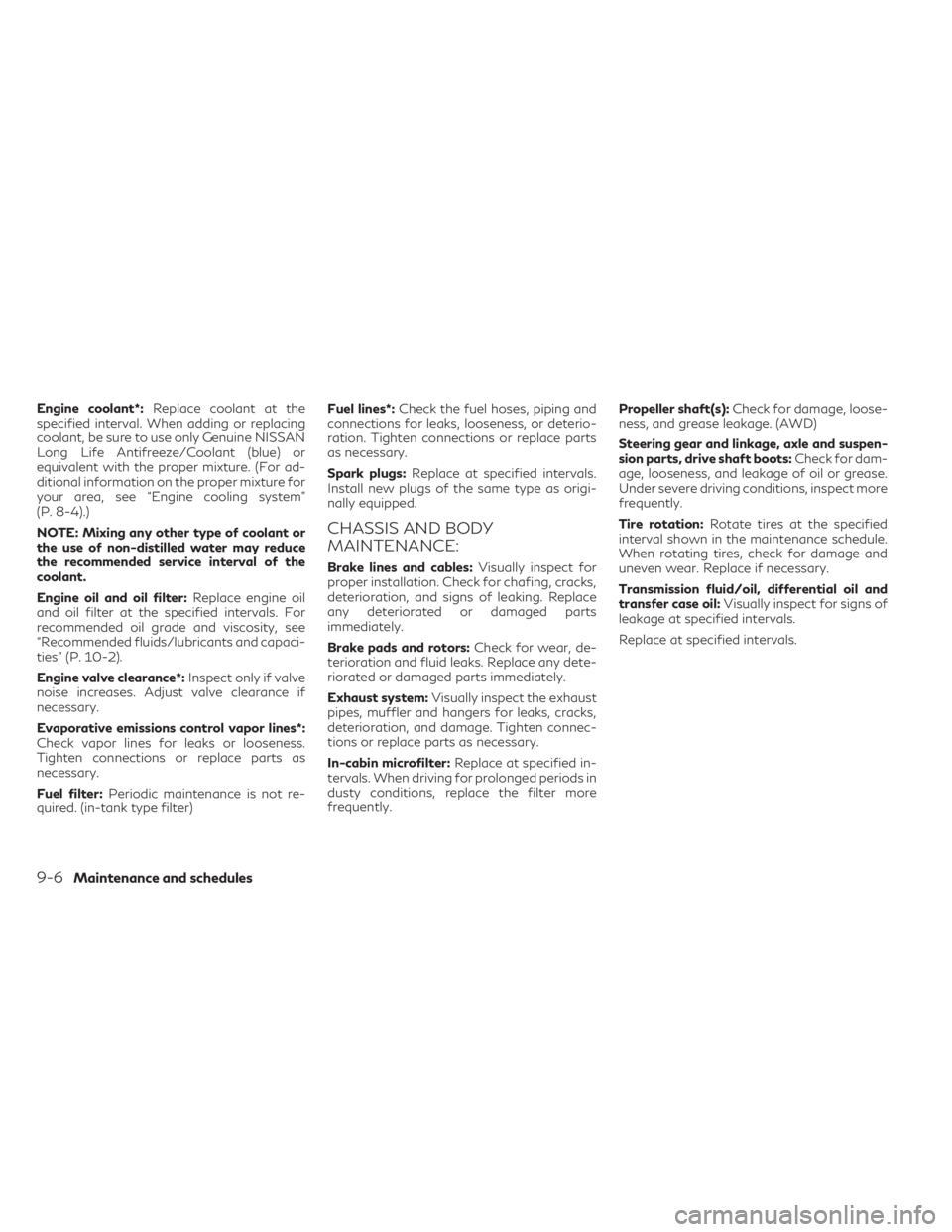
Engine coolant*:Replace coolant at the
specified interval. When adding or replacing
coolant, be sure to use only Genuine NISSAN
Long Life Antifreeze/Coolant (blue) or
equivalent with the proper mixture. (For ad-
ditional information on the proper mixture for
your area, see “Engine cooling system”
(P. 8-4).)
NOTE: Mixing any other type of coolant or
the use of non-distilled water may reduce
the recommended service interval of the
coolant.
Engine oil and oil filter: Replace engine oil
and oil filter at the specified intervals. For
recommended oil grade and viscosity, see
“Recommended fluids/lubricants and capaci-
ties” (P. 10-2).
Engine valve clearance*: Inspect only if valve
noise increases. Adjust valve clearance if
necessary.
Evaporative emissions control vapor lines*:
Check vapor lines for leaks or looseness.
Tighten connections or replace parts as
necessary.
Fuel filter: Periodic maintenance is not re-
quired. (in-tank type filter) Fuel lines*:
Check the fuel hoses, piping and
connections for leaks, looseness, or deterio-
ration. Tighten connections or replace parts
as necessary.
Spark plugs: Replace at specified intervals.
Install new plugs of the same type as origi-
nally equipped.
CHASSIS AND BODY
MAINTENANCE:
Brake lines and cables: Visually inspect for
proper installation. Check for chafing, cracks,
deterioration, and signs of leaking. Replace
any deteriorated or damaged parts
immediately.
Brake pads and rotors: Check for wear, de-
terioration and fluid leaks. Replace any dete-
riorated or damaged parts immediately.
Exhaust system: Visually inspect the exhaust
pipes, muffler and hangers for leaks, cracks,
deterioration, and damage. Tighten connec-
tions or replace parts as necessary.
In-cabin microfilter: Replace at specified in-
tervals. When driving for prolonged periods in
dusty conditions, replace the filter more
frequently. Propeller shaft(s):
Check for damage, loose-
ness, and grease leakage. (AWD)
Steering gear and linkage, axle and suspen-
sion parts, drive shaft boots: Check for dam-
age, looseness, and leakage of oil or grease.
Under severe driving conditions, inspect more
frequently.
Tire rotation: Rotate tires at the specified
interval shown in the maintenance schedule.
When rotating tires, check for damage and
uneven wear. Replace if necessary.
Transmission fluid/oil, differential oil and
transfer case oil: Visually inspect for signs of
leakage at specified intervals.
Replace at specified intervals.
9-6Maintenance and schedules
Page 571 of 636
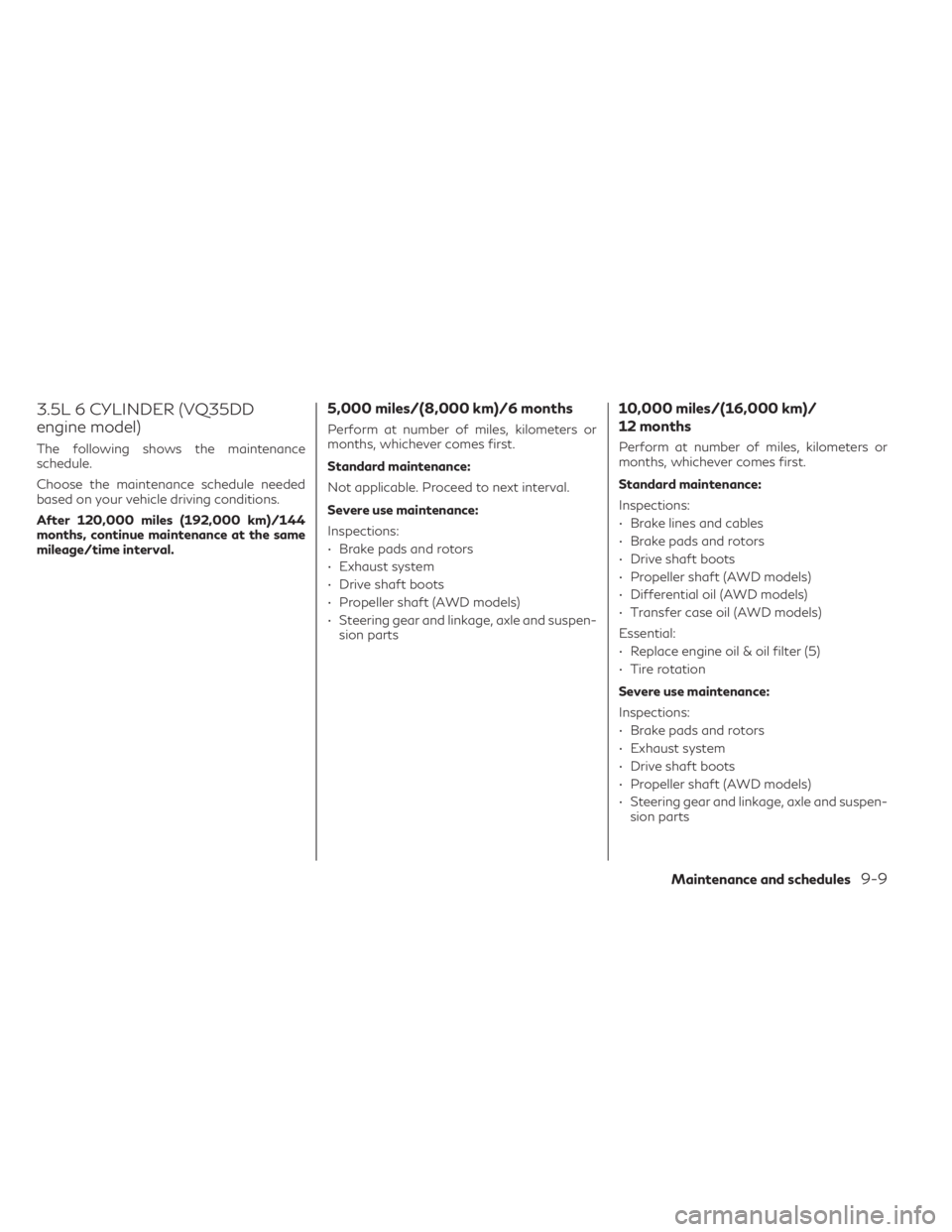
3.5L 6 CYLINDER (VQ35DD
engine model)
The following shows the maintenance
schedule.
Choose the maintenance schedule needed
based on your vehicle driving conditions.
After 120,000 miles (192,000 km)/144
months, continue maintenance at the same
mileage/time interval.
5,000 miles/(8,000 km)/6 months
Perform at number of miles, kilometers or
months, whichever comes first.
Standard maintenance:
Not applicable. Proceed to next interval.
Severe use maintenance:
Inspections:
• Brake pads and rotors
• Exhaust system
• Drive shaft boots
• Propeller shaft (AWD models)
• Steering gear and linkage, axle and suspen-sion parts
10,000 miles/(16,000 km)/
12 months
Perform at number of miles, kilometers or
months, whichever comes first.
Standard maintenance:
Inspections:
• Brake lines and cables
• Brake pads and rotors
• Drive shaft boots
• Propeller shaft (AWD models)
• Differential oil (AWD models)
• Transfer case oil (AWD models)
Essential:
• Replace engine oil & oil filter (5)
• Tire rotation
Severe use maintenance:
Inspections:
• Brake pads and rotors
• Exhaust system
• Drive shaft boots
• Propeller shaft (AWD models)
• Steering gear and linkage, axle and suspen-sion parts
Maintenance and schedules9-9
Page 572 of 636
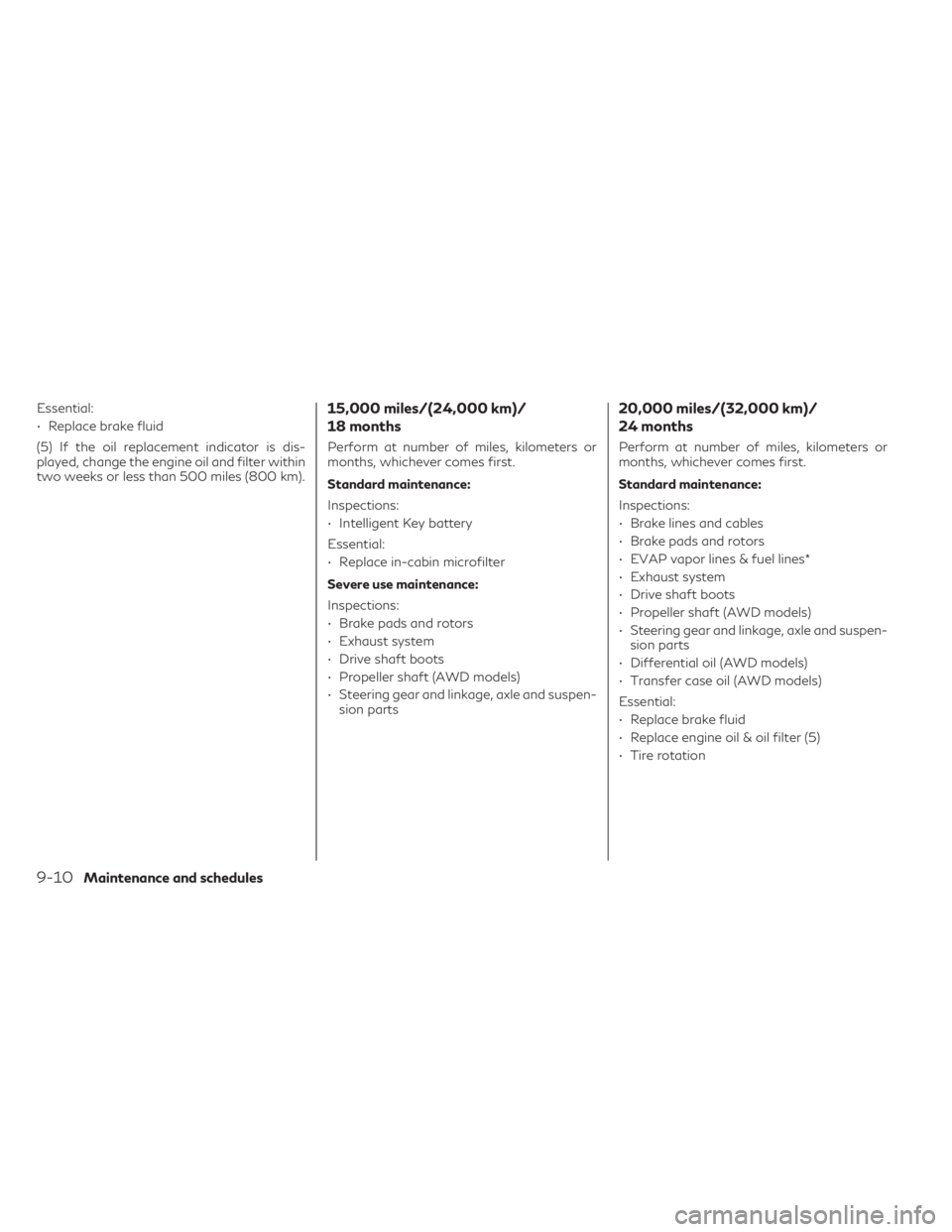
Essential:
• Replace brake fluid
(5) If the oil replacement indicator is dis-
played, change the engine oil and filter within
two weeks or less than 500 miles (800 km).15,000 miles/(24,000 km)/
18 months
Perform at number of miles, kilometers or
months, whichever comes first.
Standard maintenance:
Inspections:
• Intelligent Key battery
Essential:
• Replace in-cabin microfilter
Severe use maintenance:
Inspections:
• Brake pads and rotors
• Exhaust system
• Drive shaft boots
• Propeller shaft (AWD models)
• Steering gear and linkage, axle and suspen-sion parts
20,000 miles/(32,000 km)/
24 months
Perform at number of miles, kilometers or
months, whichever comes first.
Standard maintenance:
Inspections:
• Brake lines and cables
• Brake pads and rotors
• EVAP vapor lines & fuel lines*
• Exhaust system
• Drive shaft boots
• Propeller shaft (AWD models)
• Steering gear and linkage, axle and suspen-sion parts
• Differential oil (AWD models)
• Transfer case oil (AWD models)
Essential:
• Replace brake fluid
• Replace engine oil & oil filter (5)
• Tire rotation
9-10Maintenance and schedules
Page 573 of 636
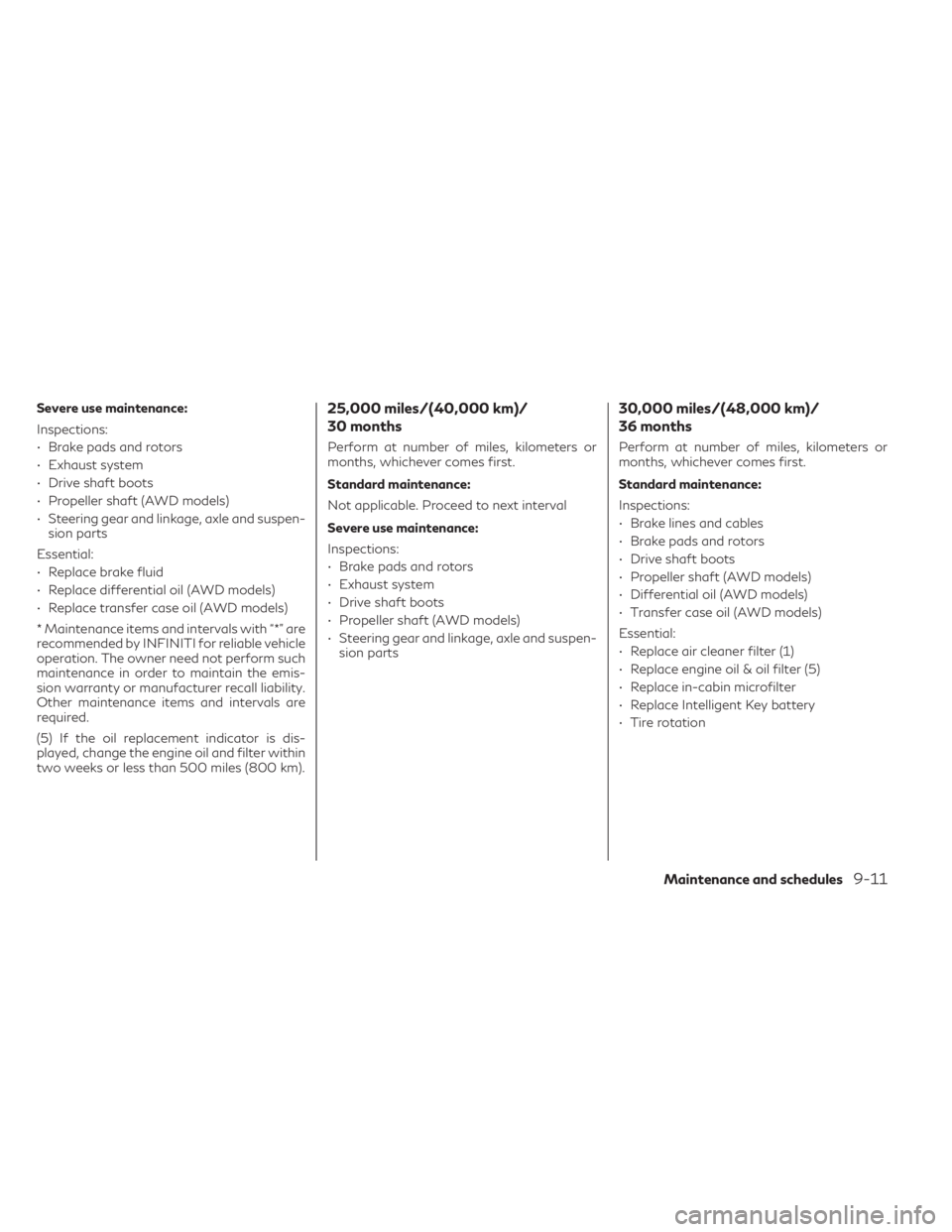
Severe use maintenance:
Inspections:
• Brake pads and rotors
• Exhaust system
• Drive shaft boots
• Propeller shaft (AWD models)
• Steering gear and linkage, axle and suspen-sion parts
Essential:
• Replace brake fluid
• Replace differential oil (AWD models)
• Replace transfer case oil (AWD models)
* Maintenance items and intervals with “*” are
recommended by INFINITI for reliable vehicle
operation. The owner need not perform such
maintenance in order to maintain the emis-
sion warranty or manufacturer recall liability.
Other maintenance items and intervals are
required.
(5) If the oil replacement indicator is dis-
played, change the engine oil and filter within
two weeks or less than 500 miles (800 km).25,000 miles/(40,000 km)/
30 months
Perform at number of miles, kilometers or
months, whichever comes first.
Standard maintenance:
Not applicable. Proceed to next interval
Severe use maintenance:
Inspections:
• Brake pads and rotors
• Exhaust system
• Drive shaft boots
• Propeller shaft (AWD models)
• Steering gear and linkage, axle and suspen- sion parts
30,000 miles/(48,000 km)/
36 months
Perform at number of miles, kilometers or
months, whichever comes first.
Standard maintenance:
Inspections:
• Brake lines and cables
• Brake pads and rotors
• Drive shaft boots
• Propeller shaft (AWD models)
• Differential oil (AWD models)
• Transfer case oil (AWD models)
Essential:
• Replace air cleaner filter (1)
• Replace engine oil & oil filter (5)
• Replace in-cabin microfilter
• Replace Intelligent Key battery
• Tire rotation
Maintenance and schedules9-11
Page 574 of 636
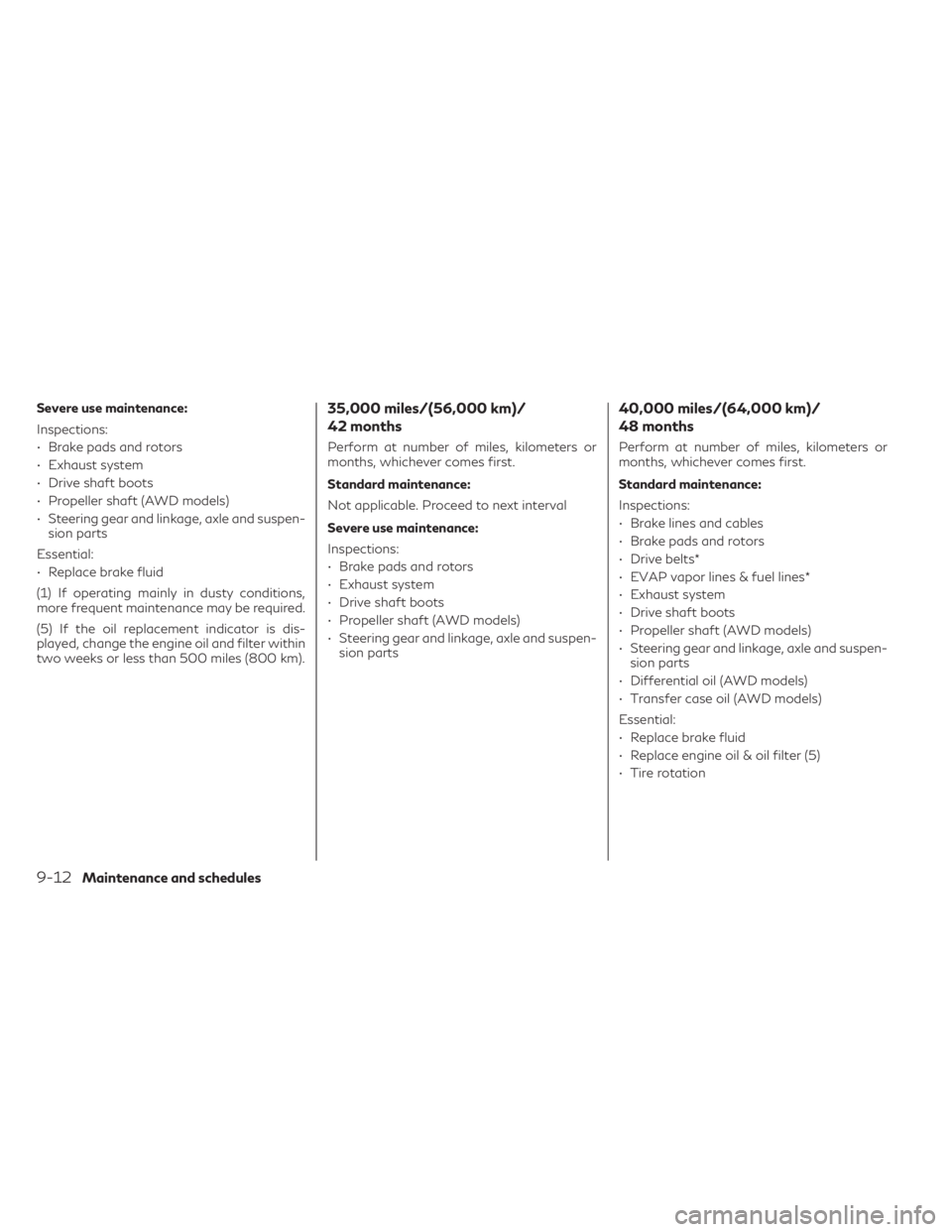
Severe use maintenance:
Inspections:
• Brake pads and rotors
• Exhaust system
• Drive shaft boots
• Propeller shaft (AWD models)
• Steering gear and linkage, axle and suspen-sion parts
Essential:
• Replace brake fluid
(1) If operating mainly in dusty conditions,
more frequent maintenance may be required.
(5) If the oil replacement indicator is dis-
played, change the engine oil and filter within
two weeks or less than 500 miles (800 km).35,000 miles/(56,000 km)/
42 months
Perform at number of miles, kilometers or
months, whichever comes first.
Standard maintenance:
Not applicable. Proceed to next interval
Severe use maintenance:
Inspections:
• Brake pads and rotors
• Exhaust system
• Drive shaft boots
• Propeller shaft (AWD models)
• Steering gear and linkage, axle and suspen- sion parts
40,000 miles/(64,000 km)/
48 months
Perform at number of miles, kilometers or
months, whichever comes first.
Standard maintenance:
Inspections:
• Brake lines and cables
• Brake pads and rotors
• Drive belts*
• EVAP vapor lines & fuel lines*
• Exhaust system
• Drive shaft boots
• Propeller shaft (AWD models)
• Steering gear and linkage, axle and suspen-sion parts
• Differential oil (AWD models)
• Transfer case oil (AWD models)
Essential:
• Replace brake fluid
• Replace engine oil & oil filter (5)
• Tire rotation
9-12Maintenance and schedules
Page 575 of 636
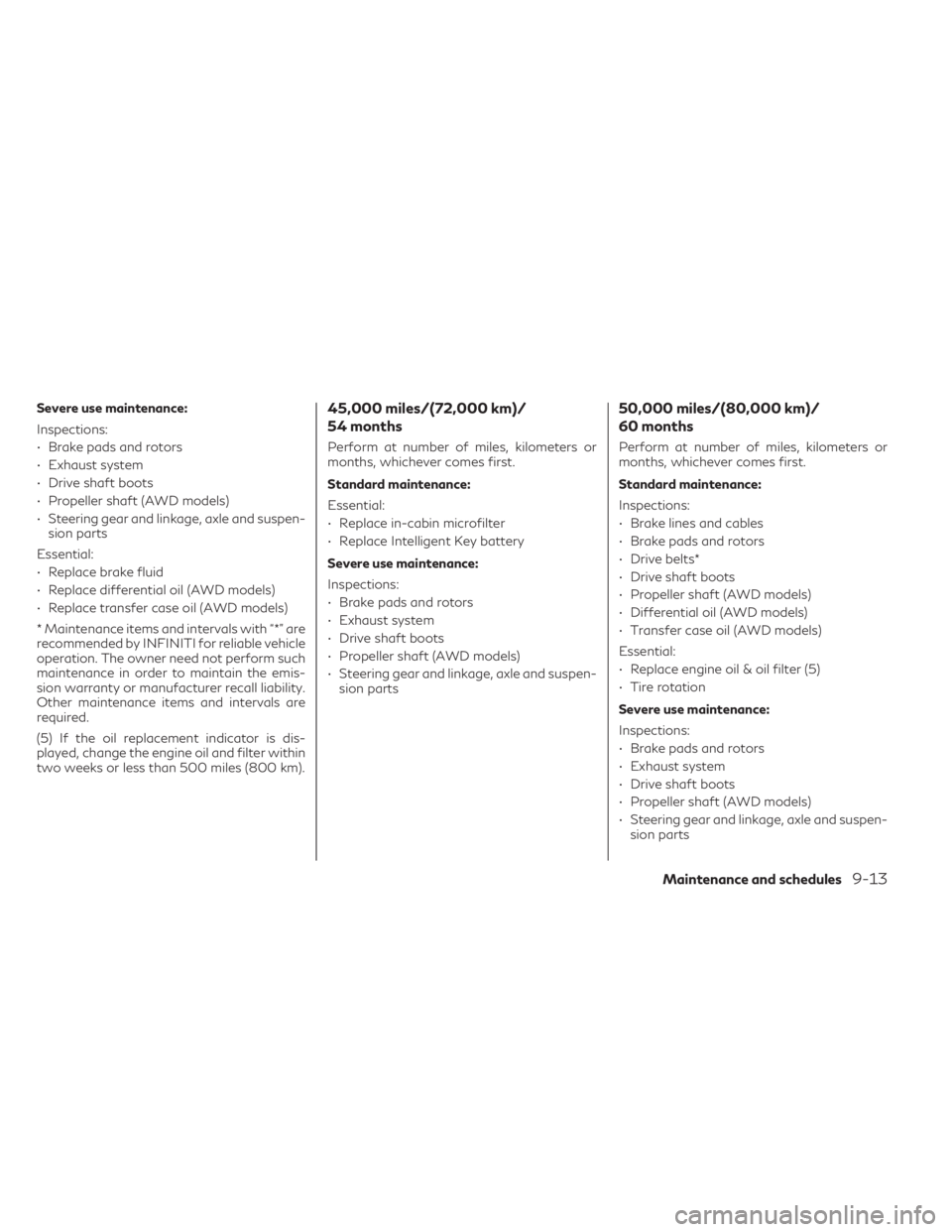
Severe use maintenance:
Inspections:
• Brake pads and rotors
• Exhaust system
• Drive shaft boots
• Propeller shaft (AWD models)
• Steering gear and linkage, axle and suspen-sion parts
Essential:
• Replace brake fluid
• Replace differential oil (AWD models)
• Replace transfer case oil (AWD models)
* Maintenance items and intervals with “*” are
recommended by INFINITI for reliable vehicle
operation. The owner need not perform such
maintenance in order to maintain the emis-
sion warranty or manufacturer recall liability.
Other maintenance items and intervals are
required.
(5) If the oil replacement indicator is dis-
played, change the engine oil and filter within
two weeks or less than 500 miles (800 km).45,000 miles/(72,000 km)/
54 months
Perform at number of miles, kilometers or
months, whichever comes first.
Standard maintenance:
Essential:
• Replace in-cabin microfilter
• Replace Intelligent Key battery
Severe use maintenance:
Inspections:
• Brake pads and rotors
• Exhaust system
• Drive shaft boots
• Propeller shaft (AWD models)
• Steering gear and linkage, axle and suspen- sion parts
50,000 miles/(80,000 km)/
60 months
Perform at number of miles, kilometers or
months, whichever comes first.
Standard maintenance:
Inspections:
• Brake lines and cables
• Brake pads and rotors
• Drive belts*
• Drive shaft boots
• Propeller shaft (AWD models)
• Differential oil (AWD models)
• Transfer case oil (AWD models)
Essential:
• Replace engine oil & oil filter (5)
• Tire rotation
Severe use maintenance:
Inspections:
• Brake pads and rotors
• Exhaust system
• Drive shaft boots
• Propeller shaft (AWD models)
• Steering gear and linkage, axle and suspen-sion parts
Maintenance and schedules9-13